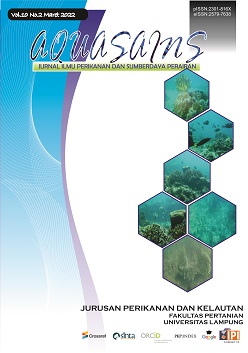DISTRIBUTION ANALYSIS AND MARKETING MARGINS OF FRESH FISH CATCHES IN TPI SENDANGBIRU, MALANG REGENCY, EAST JAVA
DOI:
https://doi.org/10.23960/aqs.v10i2.p1077-1100 Abstract View: 299
Abstract View: 299
Abstract
Based on data from the Department of Maritime Affairs and Fisheries of Malang Regency, Sumbermanjing sub-district is the largest capture fishery producing sub-district in Malang Regency. The purpose of this study is to find out how efficient the marketing channels are at TPI Sendangbiru. This research was conducted descriptively using a survey method in the field. Data collection was obtained through sampling (primary data) and statistical data collection owned by TPI Sendangbiru. There are 5 marketing channel patterns in TPI Sendangbiru. Each type of fish has a different marketing flow. The value of marketing efficiency for each type of fish in each marketing channel has various values. The efficiency value in marketing tuna and albakor has the same marketing channel and value, namely 2%, for marlin fish 3%. The baby tuna fish have 5 marketing channel patterns of 4%, 5%, 3%, 4%, and 5%. On tuna, lemuru, and kite also have 5 patterns of marketing channels. The value of marketing efficiency of tuna is 6%, 6%, 4%, 5%, and 6%, the value of marketing efficiency of lemuru is 7%, 8%, 5%, 6%, and 8%. The value of the marketing efficiency of scad fish is 6%, 7%, 4%, 6%, and 7%.Downloads
Download data is not yet available.
Downloads
Published
2022-03-20
How to Cite
Fiddyawati, E., Sawiji, A., & Setiawan, F. (2022). DISTRIBUTION ANALYSIS AND MARKETING MARGINS OF FRESH FISH CATCHES IN TPI SENDANGBIRU, MALANG REGENCY, EAST JAVA. Aqusains: Jurnal Ilmu Perikanan Dan Sumberdaya Perairan, 10(2), 1077–1100. https://doi.org/10.23960/aqs.v10i2.p1077-1100
Issue
Section
Articles

.png)










